Sciatic Endometriosis
Sciatic endometriosis is a rare condition that occurs when endometrial tissue (the tissue that lines the uterus) grows outside the uterus, typically in the pelvis, and puts pressure on the sciatic nerve.
Endometriosis is a medical condition that causes endometrial tissue – similar to the tissue that lines the uterus – to grow outside the uterus, leading to pain, irregular periods, and infertility.
In some cases, these growths of endometrial tissue, also known as lesions or implants, can put pressure on the sciatic nerve. This condition is known as sciatic endometriosis, and it can cause leg pain and weakness, particularly around the time of menstrual cycles. The sciatic nerve runs from the lower back down to the back of each thigh.

Sciatica Nerve (Image source: ShareAlike 4.0 International)
Causes of Sciatic Endometriosis
The exact cause of sciatic endometriosis is not yet fully understood, but it is believed to occur when endometrial tissue grows outside the uterus and attaches to or infiltrates the sciatic nerve.
Endometrial tissue can grow in different areas of the body due to a process called retrograde menstruation. During menstruation, some endometrial tissue flows backwards through the fallopian tubes and into the pelvic cavity instead of being expelled from the body. This misplaced tissue can then implant and grow on organs and tissues outside of the uterus, including the sciatic nerve.
Other factors that may contribute to the development of sciatic endometriosis include genetics, hormonal imbalances, immune system dysfunction, and environmental toxins.
Risk factors for endometriosis, such as a family history of the condition, early onset of menstrual periods, and prolonged menstrual cycles, may also increase the risk of developing sciatic endometriosis.
If sciatic endometriosis is the underlying cause of the sciatica, leg pain may emerge or worsen just before or during menstrual periods. This is because endometriosis is linked to hormonal changes, and as estrogen and progesterone fluctuate during the menstrual cycle, they can trigger pain in the legs.
Symptoms of Sciatic Endometriosis
Sciatic endometriosis can lead to similar symptoms as other causes of sciatica. The nature and severity of pain symptoms can vary based on the location and degree of nerve compression. Common symptoms associated with sciatic endometriosis include:
- Pain in the legs, hips, lower back, or buttocks
- Numbness or tingling in the lower body
- Radiating leg pain
- Chronic pelvic pain
- Muscle weakness
- Loss of balance
- Foot drop
Sciatica usually affects one side of the body, but it can cause symptoms on both sides. The intensity of sciatic pain can range from mild discomfort to severe pain.
It’s important to note that these symptoms can be caused by other conditions as well, and not all women with sciatic endometriosis will experience all of these symptoms. If you are experiencing any of these symptoms, it’s important to request an appointment with New York Gynecology Endometriosis (NYGE) to determine the underlying cause and appropriate endometriosis treatment.
Diagnosis of Sciatic Endometriosis
Sciatic endometriosis can be challenging to diagnose since it typically mimics the symptoms of sciatica. Nonetheless, it usually occurs alongside regular endometriosis. If a woman has already been diagnosed with endometriosis and experiences sciatica symptoms, sciatic endometriosis may be suspected. Imaging techniques such as magnetic electromyography, computed tomography (CT) scan, magnetic resonance imaging (MRI), or surgery may be used to diagnose the condition.
Additionally, a test called Lasègue’s test or straight leg raise test can provide an indication of sciatic endometriosis. During the test, the patient lies on her back, and the doctor raises the patient’s legs with the knees kept straight. If the sciatic nerve is under pressure due to sciatic endometriosis, the patient will experience sciatic pain when the legs reach an angle of 30 to 70 degrees relative to the examination table.
Early diagnosis is crucial since sciatic endometriosis can result in irreversible nerve damage caused by recurrent bleeding and scarring if left untreated.
Surgical Methods for the Treatment of Sciatic Endometriosis
The most effective treatment for sciatic endometriosis is surgical removal of the endometrial tissue that is compressing the sciatic nerve. Surgery can also help to address any scarring or adhesions that may have formed due to the condition.
Laparoscopic Surgery
Laparoscopic surgery is a minimally invasive surgical technique that may be used to remove endometrial tissue causing sciatic endometriosis. The procedure involves making small incisions in the abdomen through which a tiny camera and surgical instruments are inserted.
During laparoscopic surgery for sciatic endometriosis, the surgeon will locate and remove the endometrial lesions causing pressure on the sciatic nerve. This may involve removing small pieces of tissue or larger, more extensive areas of endometriosis.
One advantage of laparoscopic surgery is that it typically results in less pain and scarring than open surgery. It also typically has a shorter recovery time, with most patients able to return to their normal activities within a few days to a week.
However, laparoscopic surgery may not be appropriate for all cases of sciatic endometriosis, particularly in cases where the endometrial lesions are extensive or in difficult-to-reach areas. In such cases, open surgery may be necessary to remove the affected tissue. The choice of surgical approach will depend on the individual case and the judgment of the treating physician.
Open Surgical Approach
Open surgical approaches to treating sciatic endometriosis involve making a larger incision in the abdomen or pelvis to access the affected area. This technique is typically reserved for cases where laparoscopic or robotic-assisted surgery is not feasible or safe.
During open surgery, the surgeon may remove the affected tissue, scar tissue, and endometrial lesions from around the sciatic nerve. The procedure may also involve repairing any damage to the nerve itself, such as removing any constrictions or freeing it from any adhesions.
Open surgical approaches for sciatic endometriosis can be more invasive than laparoscopic or robotic-assisted surgery and may require a longer hospital stay and recovery time. Additionally, open surgery can result in more scarring and pain than the less invasive approaches. However, in some cases, open surgery may be the best option for treating severe or complicated cases of sciatic endometriosis.
The cost of open surgical approaches for sciatic endometriosis can vary depending on several factors such as the location of the medical facility, the surgeon’s fees, and any additional charges associated with the procedure. It is important for patients to discuss the potential costs and any insurance coverage or payment options with New York Gynecology Endometriosis (NYGE) and insurance provider.
Robotic-Assisted Laparoscopic Surgery
Robotic-assisted laparoscopic surgery is a minimally invasive surgical technique that uses a robotic system to aid in performing the procedure. The robotic system consists of a console operated by the surgeon, which controls the robotic arms that hold the surgical instruments. This allows for greater precision and dexterity during the surgery.
Robotic-assisted laparoscopic surgery for sciatic endometriosis is a newer and less commonly used technique compared to traditional laparoscopic surgery. The cost of this procedure can vary depending on several factors such as the location of the medical facility, the surgeon’s fees, and any additional charges associated with the use of the robotic system.
As with any medical procedure, it is important for patients to check with their insurance provider and the treating physician to determine the expected cost of the procedure and any potential out-of-pocket expenses they may incur. It is also important to discuss any potential financial assistance or payment options that may be available.
Pankaj Singhal, MD, MS, MHCM
Master Surgeon in Robotic Surgery
Dr. Pankaj Singhal, a globally recognized endometriosis surgeon, possesses over 25 years of expertise in laparoscopic excision surgery, enabling him to tackle even the most challenging endometriosis cases with confidence. Dr. Pankaj treats patients with diverse endometriosis-related conditions, ranging from ovarian endometriomas to severe deep infiltrating endometriosis that affects the bowels and other organs.
Dr. Pankaj prioritizes minimally invasive surgery and provides comprehensive personal care. Additionally, he is the owner and founder of New York Gynecology and Endometriosis (NYGE), and has dedicated his life to advocating for, respecting, and treating women suffering from this little-known disease. He is one of the few surgeons in the entire United States who have completed over 5,718 robot-assisted gynecologic surgeries.

We Accept Most Major Insurance Plans
Convenient Billing Options for Comprehensive Coverage.
Surgeries are typically covered by health insurance. However, the extent of coverage can vary depending on the specific insurance plan and policy. Some insurance plans may cover a broad range of surgical procedures, including both elective and necessary surgeries, while others may have limitations or exclusions for certain procedures.
In some cases, certain insurance plans or programs may fully cover the cost of surgery, leaving the patient with no financial responsibility.
Request an Appointment with
New York Gynecology Endometriosis
"*" indicates required fields
